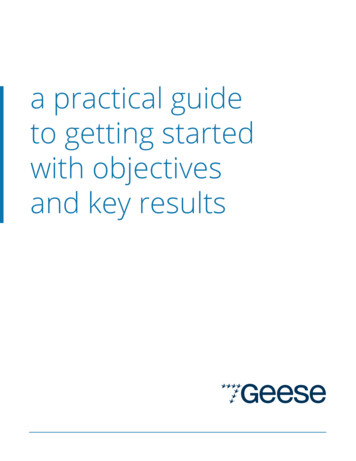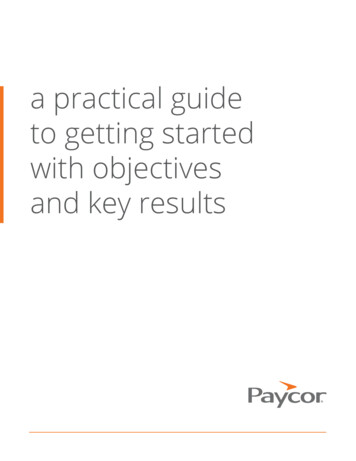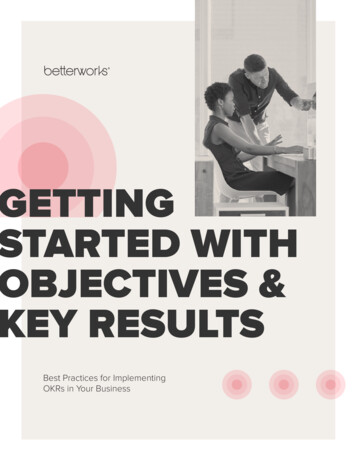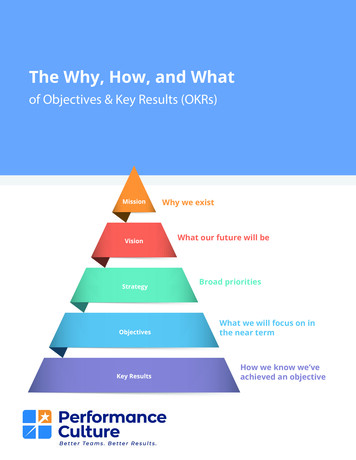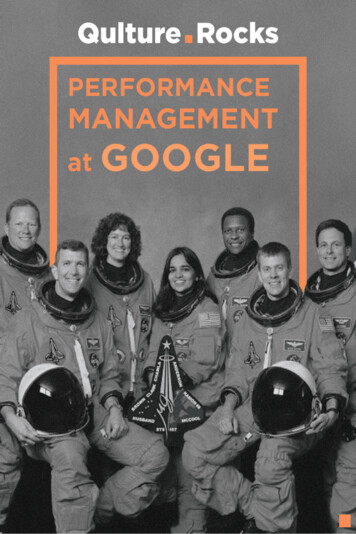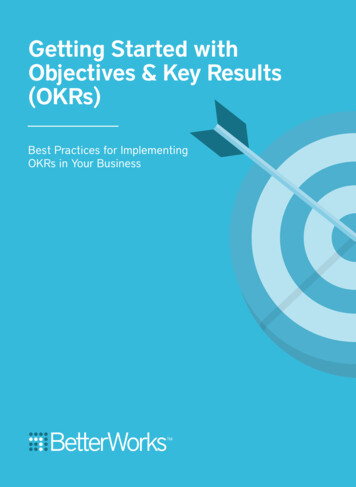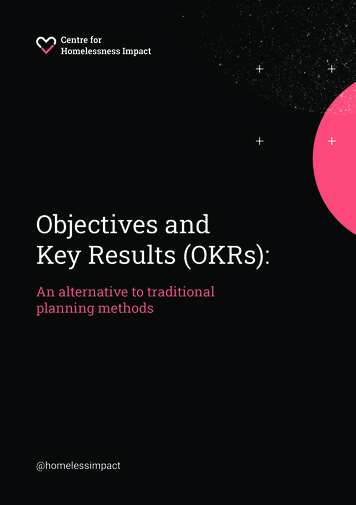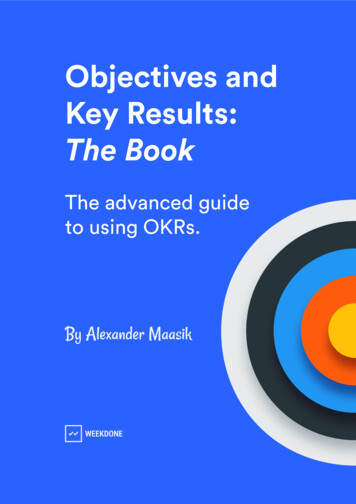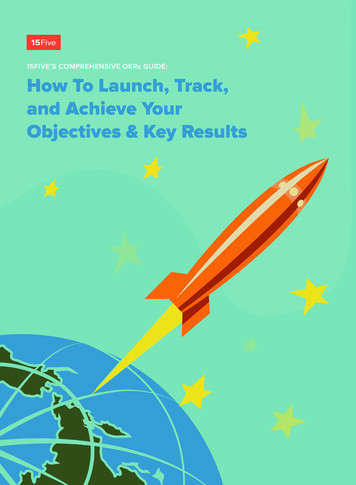
Transcription
15FIVE’S COMPREHENSIVE OKRs GUIDE:How To Launch, Track,and Achieve YourObjectives & Key Results
Introduction:On July 20, 1969, the first two humans walked on the surface of the moon, with one of them remarking, “That’sone small step for [a] man, one giant leap for mankind”. Nearly 50 years later NASA declares, “we are goingto the moon—to stay”, heralding the delivery of permanent tech to the lunar surface by private companies. Wehave to wonder, how do monumental feats of achievement like these occur?It all begins with inspiration. Someone pointed at the largest visible object in the sky and said, “we’re goingthere”. Next comes the strategy—countless teams planned and executed their small part, measuring progressalong the way.Your company is probably not going to have the 400,000 engineers, scientists and technicians who helpedaccomplish the moon landings, and you may not be able to point at the moon to inspire. But you can make theseemingly impossible happen with a process called Objectives and Key Results (OKRs).Thanks to tech giants like Intel and Google, and John Doerr’s book, Measure What Matters, many are nowfamiliar with this framework for defining and tracking the highest leverage business priorities and theiroutcomes.Objectives are what the organization, team, or individual wants to accomplish, and are typically qualitative andtime-bound. The Key Results are concrete, specific, and measurable, and describe how you’ll accomplish theObjective. The objective is the what, and the key results are the how, where, and when.As a company leader, your job is to create the what—a clear vision for everyone to align with to achievesuccess. Without vision, your people are basically walking around in a fog. They may be “moving needles”, butwithout your vision as a leader, they cannot possibly hope to contribute in a meaningful way to a prosperousquarter or year for your company.Whatever your version of landing on the moon, this book is designed to help you get there. It’s a resource formanagers at all levels to implement the company-wide objectives established by leadership. We’ve includeddetails for working with every employee so that they have measurable objectives that impact the entirecompany each quarter of the year.The process of creating, measuring, and learning from OKRs can seem deceptively simple, but it doesn’t haveto be overly complicated either. Here are just a handful of questions you’ll encounter: How many company-wide, team, and individual objectives should we have?Will objectives be rigid or can they be adjusted during the quarter to match business needs?How will we track our OKRs company-wide?Should they be aspirational based (ambitious stretch goals) or commitment based (designed as a way totrack progress, with 100% completion required)?Can OKRs be used to determine promotions and salary increases?Each business is different, with a unique culture, business model, and leadership philosophy. In this eBookwe’ll discuss OKRs as part of your larger performance management strategy, share the latest research so thatyou can determine why a particular course is right for you, and we’ll share rollout strategies and best practices.OKRs can benefit any business enterprise,but how exactly can they help yours?
TABLEOF CONTENTS1.Preparing for Launch2.Fitting OKRs Into Your PerformanceManagement Strategy3.Launching Your OKRs4.Setting Individual Objectives That Motivate5.Best Practices for Writing OKRs6.Critiques of the System7.Tracking Progress(OKRs as a Data Repository)
PREPARINGFOR LAUNCHThe practice of OKRs was invented at Intel in the 1970s as thecompany pivoted to create computer processors instead ofmemory chips. Managers across the various teams used OKRsto prioritize quarterly goals for employees that were alignedwith Intel’s greater company goals. By the time the personalcomputer revolution began, Intel was using OKRs to becomeone of the world’s largest manufacturers of microprocessors.Today, most of Silicon Valley uses the OKR model as a way toquantify what they are working on and measure their ability toachieve those goals. The main idea is to prioritize larger, moreimportant goals and then focus on the finer details.In The Seven Habits of Highly Effective People, Steven Coveyprovided the analogy of placing rocks into a jar. Just like theworkday, the jar has limited space. When people begin with thesand and pebbles (the small tasks), they will not have room forthe large rocks (the more important, time-consuming tasks). Tomake everything fit, Covey suggests putting the rocks in first,then the pebbles, sand and water. Starting the day with the mostimportant tasks first allows for plenty of time for all the smaller,less important things.The same logic is applied to each quarter of the year. Focus onlyon 1-3 major objectives that are aligned with the company goals,because the path to success lies in clarifying and finding theleverage.3 15Five’s Comprehensive OKRs Guide
BENEFITS OFCREATING OKRSFOR CEO’S Goal focused companyalignment: align with yourleadership team on toppriorities and highest leverageactivities each quarter Fit Objectives into companyvision, mission, and values tomotivate your company withpurpose Visibility into company,department and individualprogress, wins, androadblocked areasTHE OKR PROCESS BASICALLY WORKS LIKE THIS: The company sets 3-5 objectives at the beginning of each period. Each team sets 1-3 objectives that are aligned with the overarchingcompany ones. Each employee sets 1-3 objectives and key results for eachobjective, aligned with team and company goals. Employees and managers gain mutual agreement on set OKRsas stretch goals that are not easily achievable and are not tied toperformance evaluations. Employees evaluate goals (score them) at the end of each quarter(Targets set by the company can be between 50-70% success foraspirational OKRs or 100% for commitment-based OKRs.) Employees and managers decide whether employees shouldcontinue incomplete objectives (which only occurs if they are stillimportant to the business). During a quarterly review, celebrate the wins and learn from thefailures.4 15Five’s Comprehensive OKRs GuideFOR MANAGERS Keep your team focused,inspired, and aligned byproviding context and directionand setting top priorities eachquarter Increase growth mindset,focus on progress overresults, and use goal settingand achievement as learningopportunities Improve manager feedbackthrough objective focusedmanagementFOR TEAM MEMBERS Feel more purpose by aligningindividual goals to companygoals to see how individualwork drives company goalsforward Visibility into companypriorities, updates, andchanges that impact individualwork Identify skills gaps and createlearning goals to keep growthand development front andcenter Increase accountabilitythrough transparent Objectives
FITTING OKRSINTO YOURPERFORMANCEMANAGEMENTSTRATEGYEvery company has metrics and KPIs in place to regularlyobserve and measure performance, but when it comesto assessing people, quantitative analysis is only half thestory. The other half of analyzing employee performanceand team dynamics involves listening to employees toget a complete picture of the health of a people-centeredorganization.Managers often look at data in a vacuum instead of takinga step back to see what employee behaviors influencedthem. It can be dangerous to run a business by removingthe story of what’s really going on and why, from thenumbers you see.The OKRs platform is meant to be used in tandem witha Weekly Check-in that provides visibility into the worldof each employee. Managers can uncover employeechallenges so that they can offer support, and even findout what’s going on in an employee’s personal life thatmight be affecting work performance. Together these twopractices offer managers an elegant solution for receivingemployee feedback and responding in a way that re-alignsemployees with their quarterly objectives.“[Performance management]practices are mutuallyreinforcing: implementingone practice well can havea positive effect on theperformance of others andleads to more effectiveperformance managementoverall.Source: McKinsey & Company5 15Five’s Comprehensive OKRs Guide
Align everyone around topcompany priorities.Get a pulse of team morale andperformance.Boost employeeperformance,every week.Remove roadblocks and coachemployees.Recognize employees and increaseengagement.Help employees grow with relevant 360 feedback and forward-looking reviews.To paraphrase the Scottish poet Andrew Lang, don’t use data as adrunken man uses a lamp post – for support rather than illumination.Without supplementing the numbers with context, leaders are justguessing about the future of their company.Company leaders who communicate with employees to discovertheir challenges and ideas are better equipped to take specificaction to remedy ailments like low output. Managers need to hearthe in-depth story behind performance issues or see what is workingso that you can replicate it elsewhere in the company.The quantitative by itself only provides half the picture, but whenmanagers have conversations early enough, so much can beaddressed before breakdown. When people can share openlybecause they don’t feel that their jobs are at risk, managers learnwhere they are struggling beyond their capacity and become awareof the things that need improvement before it’s too late.Standalone Objective tracking is insufficient for producing strongresults. To be most effective, OKRs muse be part of a completeperformance management system that includes a Weekly Check-inand 1-on-1 Meetings.6 15Five’s Comprehensive OKRs GuideBy asking the right questions every week, managers obtain deeperinsight into the motivations, distractions and other issues thatinfluence or hinder results: Managers can see where employees are challenged and offerjust enough support to allow them to grow into their roles andachieve their goals. Employees have the opportunity to share triumphs and beacknowledged by management. Acknowledgements helpmotivate employees to perform and boosts morale. Managers can quickly and easily discover misalignments andmake weekly course corrections.Check-ins are not just about information gathering, but also aid inthe establishment of trust. Asking team-members “How do you feel?”or “Where are you challenged?”, elicits valuable information like, “Iam stressed because we re-oriented departmental procedures andit feels like there are still gaping holes in our new process”, or “I amgetting run down and can’t do my best work”.Managers can then respond to employee needs before the issuesget out of hand.
WHICH OKR SYSTEM SHOULDYOU USE? ASPIRATIONAL ORCOMMITMENT BASEDGoogle is known for setting overly ambitious objectives,and many companies followed suit. Other organizationsuse a different strategy by having teams and employeesset more attainable objectives and use OKRs as a methodfor goal tracking. Success will then be benchmarked by90-100% completion, rather than 60-70%.When company leaders connect performance on key Objectiveswith communication, they tap into the human element ofperformance. People move naturally towards doing their bestwork and becoming their best selves.Mihaly Csikszentmihalyi wrote in his bestselling book Flow: ThePsychology of Optimal Experience, “The more a job resemblesa game - with variety, appropriate and flexible challenges, cleargoals and immediate feedback -- the more enjoyable it will beregardless of the worker’s level of development”. Set goals,measure them, and then have the conversations to replicatetriumphs and remediate challenges.Gallup shows that only 34% of employees strongly agree thattheir manager knows of the projects or tasks they’re currentlyworking on. When managers keep track of goals and keyperformance projects and milestones, the feedback theyprovide improves. In the Check-in, managers move beyondresults and through the use of questions, blend qualitativefeedback into the OKR process. During 1-on-1s managers obtaindeeper insight into their team members’ work and the factorsthat influence or hinder progress.7 15Five’s Comprehensive OKRs GuideWe recommend that companies decouple stretchObjectives from pay decisions, and when assessingperformance for compensation decisions, to use data fromas many objective performance measures as possible,including both behaviors and results. For example, forsales, measure calls made and revenue growth. Formanagers, measure team results and employee retentionand promotion rates. Overall, Objectives should beused for establishing direction and setting a context forwork that motivates employees by linking their efforts tocompany priorities, thereby imbuing high leverage taskswith greater purpose and meaning.A NOTE ABOUT COMPENSATION: When we talk aboutObjectives in relation to Reviews, the most commonquestion we hear is whether goal completions should belinked to promotions and pay increases. If goals are highstretch goals, don’t link them to pay. Research showsextremely high goals combined with economic incentiveslead to unethical behavior, since tying rewards to goalachievement can create a “results at all costs” mentality.
LAUNCHING YOUR OKRS¹Company Objectives are instrumental for prioritizing focus areas, directing attention, and ensuring that everyone is aligned and motivated bycontributing to something greater than the self. It may seem like common sense, but many companies are unclear about their top prioritiesor don’t communicate them, thereby losing out on a valuable opportunity to increase performance, engagement, and motivation. Below we’lluncover the secret to effective Objective-setting at the company level:IT ALL STARTS WITH LEADERSHIP. A strong OKR processstarts with the CEO and/or senior leadership team, the peopleresponsible for setting the direction of the company. Not onlyto develop yearly and quarterly Objectives, but to be the chiefadvocate(s) of the company mission, vision, and values. Objectivestranslate strategy into organizational priorities.Company Objectivesprovide context and direction for employees to align their effortswith team and organizational goals. Every company leader must helpemployees connect their work to the deeper purpose, and make surethe entire company is informed, aligned, and inspired to focus onwhat matters most.We recommend that top leadership set company Objectives first,followed by nested department-level Objectives that support thelevel above, and then allow team members to align their individualObjectives with the department and company Objectives. Gallupresearch shows employees who strongly agree that they can link8 15Five’s Comprehensive OKRs Guidetheir goals to the organization’s goals are 3.5 times more likely to beengaged.ENSURE ALIGNMENT. Can you name your companies top threepriorities? Only 2% of employees can, even though executivespredicted 64% would be able to do so. One reason for this disparityis that many companies set way too many company Objectivesmaking it hard for employees to keep track. Morten Hansen, Berkeleymanagement professor and author of Great at Work, shows that highperforming individuals and companies ‘do less and then obsess.’In other words, business tasks should be reduced to the fewestpossible metrics, the fewest goals, the fewest steps, the fewest pieces.Employees and organizations who chose a few key priorities andchannel tremendous effort into doing exceptional work in those areasgreatly outperform those who overextend themselves. CEO’s areencouraged to set and prioritize a limited 3 to 5 company Objectives.
OKRS CASE STUDY LIVE INTENTLiveIntent is a people-based marketing technologyplatform that has transformed email into the simplest, mostpowerful way to market to people in a mobile-first world.It is changing the way over 2,000 of the world’s largestbrands and publishers think about email by augmentingeverything from acquisition to attribution while drivingincremental product sales and revenue.Abby Hamilton and Caitlin McCann, LiveIntent’s VP andManager of People Development, along with LiveIntent’sBusiness Operations team, recognized the need forimproved internal communications during this growthphase.MOTIVATE WITH PURPOSE.Research from famed professors Richard Ryan and Edward Deci showsthe key to intrinsic motivation is autonomy, mastery, relatedness andpurpose. Company Objectives are important because they providecontext, which creates an important line of sight to the higher-levelpurpose for people’s work. Three strategic company Objectives is all ittakes.THE IMPORTANCE OF COLLABORATIVE OBJECTIVES. Mostwork today is accomplished by teams and the research support for thebenefits of team goals is very strong. When team members can creategoals together, and see how their work contributes to the progress ofteam goals, performance improves. Collaborative Objectives enableteams to align and work together to drive company initiatives forward.STRUCTURING OKRS TO MATCH THE COMPANY. Organizations(especially larger ones) are structured in a variety of different ways, whichcan add complexity to the process of aligning employees. Alignment isnot just top-down and typically occurs in 3 ways:1.Vertical – An individual’s objectives connect to (and do notconflict with) the objectives of managers and the team.2. Company/Mission – An individual can clearly see theimportance of his or her objectives because they areconnected to the company goals and mission.3. Horizontal – An individual’s objectives connect (and do notconflict) across teams.¹ To guide our OKR philosophy and design, we turned to science for answers. Weexamined academic research on all topics related to performance managementand leveraged trustworthy research from The Center for Evidence BasedManagement, (CEBMa).In particular, employees felt out of the loop when itcame to understanding what other teams were workingon and how these efforts collectively laddered up tocompany goals. Caitlin and the Business Operations teampartnered up and began their search for a tool to unifyeveryone around overarching objectives, provide visibility,and keep more organized records of performance.Spurred on by LiveIntent’s CEO, who became excitedabout finding new ways to measure accountability, HRdecided to introduce a bona fide OKR system. This wouldoffer greater transparency into corporate objectives asthe basis for that accountability. And, with administrativetasks becoming more automated, it would also allow moretime for strategic optimization of People Ops processes.All of the 15Five software features have been universallyaccepted, but certain features have particularly resonatedamong the group, such as OKRs:Formalizing objectives allows teams to strike a betterbalance between establishing challenging-enoughgoals and subsequently achieving them. It also improvesaccountability in quarterly leadership meetings, in whichthey can celebrate what they’ve just accomplished whilesetting goals for the following quarter.“The ability to document means youcan easily revisit and have ongoingdiscussions about objectives, whichis great from an accountabilityperspective.”-Abby HamiltonVP of People Development, LiveIntent9 15Five’s Comprehensive OKRs Guide
SETTINGINDIVIDUALOBJECTIVESTHATMOTIVATEWhen we refer to Objective-setting, our definition includes what many peoplerefer to as “goal setting”. Classic research shows again and again that goals areextremely effective at increasing performance and engagement. When individualsset Objectives, they consciously decide on the goals they want to accomplish andwithin what timeframe, which steers behavior, energizes, and directs an employee’sattention. This leads to greater effort, which improves performance. However, notall goals are created equal, which is why it’s important to talk about what’s neededfor truly effective goal setting:1.GOALS SHOULD BE MEANINGFUL. Employees are more motivated toaccomplish goals that are personally meaningful. To foster intrinsic motivationin all employees, there should be a convergence of desires where businessand personal needs align. When managers and employees create individualObjectives together, they can gauge an employee’s personal interest in theirObjectives each quarter to ensure high motivation.2.LEARNING OBJECTIVES FOR GROWTH & DEVELOPMENT. Growth anddevelopment is a top driver of engagement for millennials. All employeesneed to have a certain level of training, skills, and experience to accomplishtheir work, so when employees need to acquire skills, research shows it’simportant for them to set learning goals rather than performance goals.Employees should have the option to create Learning Objectives to prioritizeany skills gaps that prohibit them from doing their best work.When it comes to Learning Objectives, specific and challenging goals havea negative effect on performance. Instead, we recommend employees setshort term and general “do your best” goals for Learning Objectives. Moregeneral learning goals increase the growth mindset, a belief that abilities arenot fixed, because people don’t worry about failure and instead see goalsetting as a chance to learn.10 15Five’s Comprehensive OKRs Guide
3.THE POWER OF PARTICIPATION: SET AND ALIGN GOALSTOGETHER. Managers have a huge opportunity to increase employeeengagement and motivation by setting goals together with their teammembers. According to Gallup, 30% of employees strongly agree thattheir manager involves them in setting their goals at work, and thosewho strongly agree with this statement are 3.6 times more likely thanother employees to be engaged. Employee participation in goal settingis important because people won’t fully commit to goals without avoice in the process. Active participation increases perceived fairness,specifically by having one’s’ voice heard.Employees should set goals with their managers but never fully alonebecause the most important driver of performance comes from theexpectations set by management.Gallup research also shows employee productivity increases by 56% onaverage when managers are involved in helping employees align theirgoals with the needs of the organization, or overall company purpose.When employees work with their managers to both create Objectivesand then align them with the organization’s mission and top priorities,productivity and engagement soar.Employees whose managerinvolves them in setting theirgoals are 3.6x more likely to beengaged at work.Employee productivity increasesby 56% when managers helpemployees align their goals withthe needs or purpose of theorganization.A NOTE ONFLEXIBILITYAccording to performance managementexpert, Alan Colquitt, Objectives shouldbe flexible enough so employees canfreely adjust, revise, or even abandon whatthey’re doing as their work evolves and aspriorities change. Research from Kuvass,Buch & Dysvik, all academics in the field oforganizational psychology, demonstrated alink between lower work performance andpeople seeing their goals as unmovable andnon-negotiable.11 15Five’s Comprehensive OKRs Guide
BEST PRACTICESFOR WRITING OKRSAs stated above, leaders must connect people’s work to a deeper purpose—the company mission.While increasing revenue, adding MQLs, or improving customer NPS by x % are all important placesto focus, most people are driven by impact, not numbers. In other words, the Key Results aremeasurable and the Objectives are what’s meaningful and inspirational.Here are some examples of Objectives in the most common categories where acompany wants to create impact: Recruit & hire phenomenal people to take us to the next level (company growth)Raise the bar on product UX (quality)Sustainable repeatable lead generation (revenue)Pay everyone generously for their hard work (performance)Here are some examples of terrible objectives: Interview 5 applicants for Design Lead April 30Increase code coverage to 90%Hit 732 ICP leads by end of Q2Build out accurate job descriptions for 75% of our jobsThe first set of examples are great Objectives because they’re time-bound, qualitative, andmeaningful. Words like “raise the bar” or “phenomenal” are designed to motivate. In contrast, eachof the terrible objectives above is too quantitative and specific, making them great key results.Here’s an example of a top-down creation of OKRs:COMPANY MISSION Create the Space for People to Become their Greatest SelvesCOMPANY OBJECTIVE -Rethink the Product Foundations to Meet Enterprise NeedsTEAM OBJECTIVE Design a flexible method for customers to categorize and find dataKEY RESULTSHave discovered the top 3 pain points from enterprise customers through interviewsand the annual feedback surveyHave validated solution with engineers and internal stakeholders with 100% approvalon designHave validated the best solution with 2 customers through feedback that has 80%avg. approval on the design12 15Five’s Comprehensive OKRs Guide
TIPS FORSTELLAR OKRSMost teams or individuals start out with way too many OKRs because they believe that’s whatit means to be ambitious. But your OKRs should never be used to set metrics that fall underthe “business as usual” or “work as usual” buckets --- it is not a laundry list of your overall workdeliverables. Nor can a team or company realistically achieve multiple extremely challenginggoals all at once that pull them in different directions and confuse them on what matters most.Get radically focused when creating OKRs. It is why it is so important to get radically focusedwhen creating OKRs. Having even just ONE powerful and hyper-focused OKR that ralliespeople to do their best work and make significant progress in this area is worth far more thanhaving a half-dozen OKRs spread across various domains of focus that produce mediocreresults because they lack prioritization.If your CEO required you to choose - which OKR would make the most significant differenceto how your company operates? Which would change the rules of the game in your industry?Which OKR would really inspire and challenge your people to do their best work? Therein lieyour answers.By this we mean balancing Commitment-based Key Results (where you are expected tohit 100% of your metric) with Aspirational-based Key Results (where you have only 50-70%chance of actually hitting your metric).Commitment based metrics are traditionally how most goal-setting methodologies haveoccurred in the past, and it is still how many organizations set goals. It can be particularlyeffective for certain goals (such as sales goals) where you really have to hit your quota to besuccessful. However, OKRs by and large ask you to go for the stretch. Why? Because those whostretch more often do more. Perhaps more than they ever imagined possible.The research for setting stretch goals goes back to Edwin Locke’s ground-breaking work inthe late 1960s that advocated for setting challenging goals. So how much does one stretch? Agoal that still has around a 50% chance of success is a happy medium, since it is both difficult,but still attainable. Set something too unattainable and you could easily get discouraged andgive up when you are still starting out but repeatedly failing. Set something too easy and you’velimited your potential.We have found that if you are still fairly new to setting and using OKRs in your organization,a good starting place to maintain this balance is to make one Key Result per Objective beaspirational in nature. The rest of the Key Results for that Objective can remain commitmentbased so you can get the satisfaction of having some successes, in addition to getting used tostretching more than usual.13 15Five’s Comprehensive OKRs Guide
We see this often when we look at the goals of organizationsstarting out with this process. They set goals that are focusedpurely on quantity-based metrics or heavily skewed towards onlytracking revenue. But goal-setting should be a balanced andnuanced process.For example, if through really hard work and substantial luck yourcompany achieves a really ambitious revenue goal for the year, butyour workforce is burned-out and attrition rates are getting high,will you really have a viable growth business left in the followingyears? If your new software release has more features than thecompetition but is riddled with bugs, at what point will it start todamage the reputation of your company?To avoid unintended consequences, be sure to counterbalancequantity metrics with quality metrics and short-term ambitions withthe long-term viability and desires of your organization. Otherwiseyou may find yourself winning the round, but losing the game.This abbreviated primer on Best Practices for creating OKRswas created by Burst Forward, a consulting and training firmthat has helped leadership teams in over a dozen industrieswith their annual goal-setting and strategy process, including15Five customers. If you could use more hands-on support inimplementing the principles mentioned here when creating yourcompany OKRs, contact Burst Forward.14 15Five’s Comprehensive OKRs Guide
CRITIQUES OF THESYSTEMNot everybody is a fan of objective based management. In this chapter we will address thesecommon critiques and misunderstandings of OKRs and similar systems:Some employees will feel overwhelmed by the 3 to 5 lofty objectives they set every quarter,and overwhelm can cause shut-down. There are a couple of ways to handle this: According to John Doerr, do not create too many key results. 3 is enough and 6 is theabsolute maximum so as not to risk overextending the team. Remember less can be morehere. Never set any business goal and simply walk away. Managers have to check in frequentlyto ensure that employees stay on track. Go beyond the metrics and ask qualitative questions. “How are you doing? What challengesare you facing? How can I help?” Break down quarterly objectives into weekly or bi-weekly goals. Taking small bi
Objectives are what the organization, team, or individual wants to accomplish, and are typically qualitative and time-bound. The Key Results are concrete, specific, and measurable, and describe how you’ll accomplish the Objective. The objective is the what, and the
